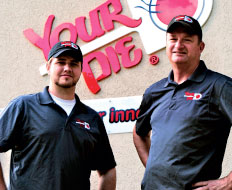After years of working in the furniture industry and spending time owning, operating, and eventually selling his stores, Paul Childers entered the quick-serve world in 2009 when a hot tip from a good friend turned Childers on to a new pizza concept called Your Pie.
Today, Childers’s two franchised units in Savannah, Georgia, are experiencing positive growth and buzz about town. Built on the backs of fresh ingredients, customer choice, family-recipe sauces, and craft-beer options, Your Pie is giving Childers’s customers something they can’t get at other fast-food brands.
Childers attributes his success to the concept and the customized, healthier choices that it offers customers, but says it hasn’t been easy; he and his team have had to battle against bigger brands on both the food and beverage side of business, using hard work and quality product to draw consumers.
Childers shares how the combination of choice, quality product, and healthy options can help a brand stand up to even the largest of competitors.
1. Mute the monotony
The reason I was attracted to Your Pie as a business was the fresh take on the mundane. There are always so many places to get a pizza, regardless of your location. Your Pie reminded me of that local pizza shop that has an edge over the big brands: It’s usually locally owned and operated by someone in the community, and run by employees who are committed to the local cause and local growth.
Your Pie took that concept, turned it into a made-to-order product, and had people coming back for more. Additionally, it was giving customers a pizza option that could be healthier and less greasy—with vegetables, gluten-free crusts, white or wheat dough, oil-based pizzas, and so on—without compromise. The choice is there for every customer across the board.
When I first started doing research for brands and quick service in general, healthy food options continued to do well in a suffering economy, and it’s not just because of the nutrition, but also the break from normalcy in letting the customer choose. A product doesn’t have to be what big brands say it should be. Moreover, the big guys are always dictating what products should look like, what the product should taste like, what the product should cost, and so on. There comes a point when the customer doesn’t want to hear it anymore, and if you have the option to cater to that decision, you’ll continue to snag their business.
2. Don’t let a slow start get you down
Our first location opened up in a downtown, tourist-heavy area in Georgia, which was both a blessing and struggle for us. We captured a lot of business right from the start because of the flux in clientele. Our second location opened up in a subtler, suburban area.
The new concept didn’t click as fast as it did with our first location. Customers took a little longer to grasp the idea of what we were trying to do with pizza. This is different from ordering a large and having it delivered to your door. You come in, select what you want, and we cook it right then and there for you. This wasn’t necessarily new to quick service, but it’s certainly new for most customers when it comes to pizza.
The reception turned out to be quite positive in our second location, which has experienced positive growth. Offering different options or a choice customers might not be used to making takes patience as a business owner when it comes to seeing if it’s paying off. However, if you’ve committed yourself to not just the brand, but also the idea, customers will latch on and notice the difference.
3. Beat convenience with quality
When it comes down to it, anybody coming into a Your Pie unit is going to have to wait around six to eight minutes for their personal, fresh pizza to fully cook in one of our brick ovens. But people keep making that decision.
There are no waiters or waitresses when it comes to table service, and the concept itself isn’t exactly a fast option compared with other food options such as burgers or sandwiches. What brings our customers back, though, is the difference in product they get and the choice they get to make, rather than us dictating it for them.
4. Develop ideas in all areas
I am a craft beer lover and supporter. I felt a very strong and positive urge to bring craft brews into the stores. The concept lends itself to fighting the bigger brands, and these craft brews are doing the same thing.
The concept of having craft beer in the units plays right into the idea that customers inevitably want the option of making decisions for themselves. More often than not, the alternative to the norm tastes better, and I just feel that the customers always want to make that distinction for themselves. If you’ve committed yourself to the brand and the idea, customers will notice. Especially when that idea is prevalent throughout the entire store and what you have to offer.










